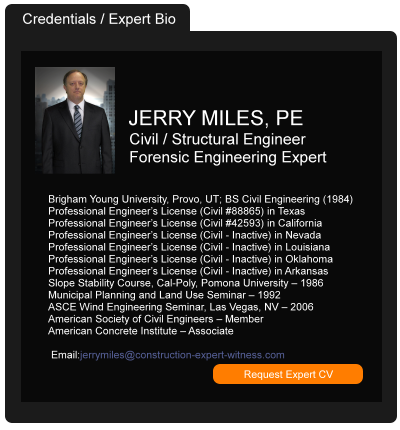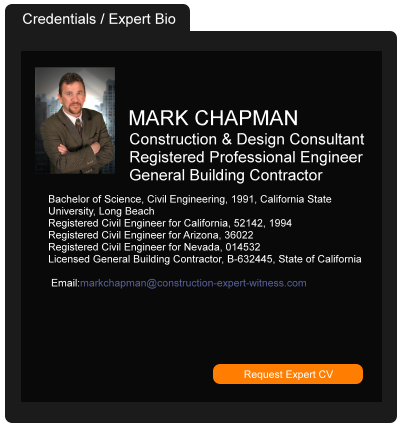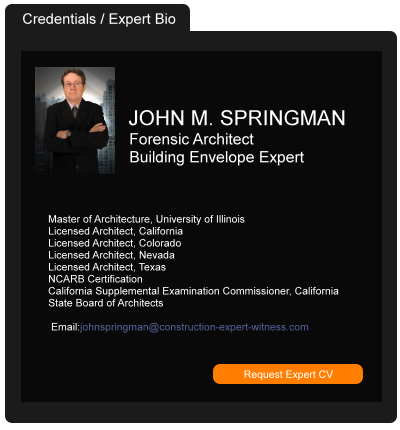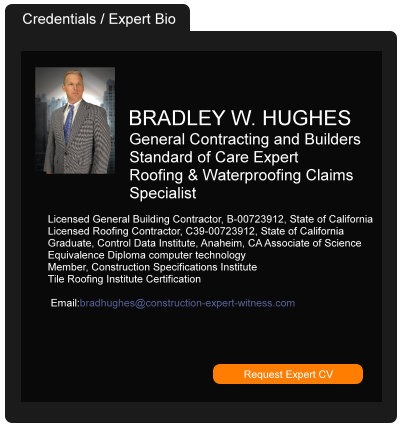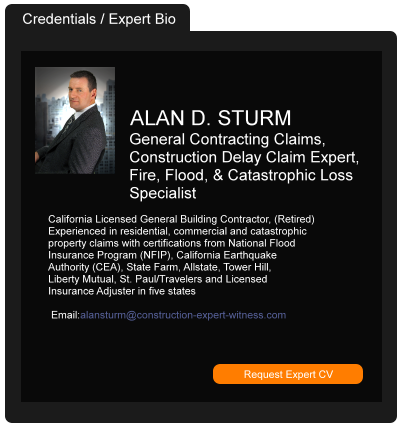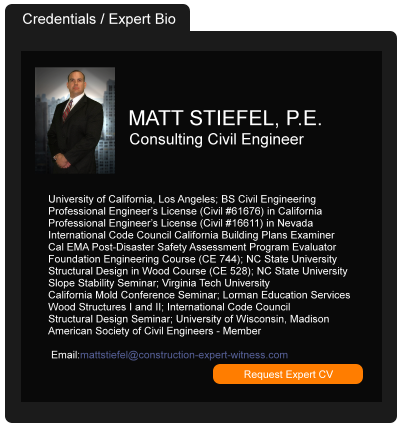Fourth Circuit Confirms Scope of “Witness Litigation Privilege”
November 21, 2018 —
Anthony B. Cavender - Gravel2GavelOn October 26, in the case of Day v. Johns Hopkins Health Sys. Corp., divided panel of the U.S. Court of Appeals for the Fourth Circuit affirmed the District Court’s ruling that the common law “Witness Litigation Privilege” protects an expert witness in a Black Lung Benefits Act benefits proceeding against civil claims that allege a federal RICO violation and Maryland state law claims for fraud, tortious interference, negligent misrepresentation and unjust enrichment attended the testimony of the expert witness.
Read the court decisionRead the full story...Reprinted courtesy of
Anthony B. Cavender, PillsburyMr. Cavender may be contacted at
anthony.cavender@pillsburylaw.com
The Importance of Engaging Design Professional Experts Early, with a Focus on Massachusetts Law
June 27, 2022 —
Jay Gregory - Gordon & Rees Construction Law BlogIn any Massachusetts case alleging negligence against a design professional, an expert witness on the topic of liability is a critical, early consideration. Given the expense of expert witnesses, counsel representing design professionals are wise to evaluate (1) the need for an expert, (2) the timing of the engagement of an expert, and (3) the scope of the expert’s services.
To begin, not every allegation of negligence against a design professional necessitates an expert opinion. “The test for determining whether a particular a particular matter is a proper one for expert testimony is whether the testimony will assist the jury in understanding issues of fact beyond their common experience.” Herbert A. Sullivan, Inc. v. Utica Mutual Insurance Co., 439 Mass. 387, 402 (2003) (addressing duties of an insurer). For instance, in its ruling in Parent v. Stone & Webster Engineering Corp., the Massachusetts Supreme Court noted no expert would be necessary to prove professional negligence where an electrician was injured by a mislabeled distribution box carrying 2,300 volts. 408 Mass. 108 (1990). It is reasonable to expect lay jurors to comprehend the duty of an electrician to properly label a distribution box carrying potentially fatal quantities of voltage. To the extent liability is readily recognizable to the average juror (i.e. “within the ken of the average juror”), significant cost savings are achievable by forgoing the use of an expert witness. That, however, is the exception.
Read the court decisionRead the full story...Reprinted courtesy of
Jay S. Gregory, Gordon Rees Scully MansukhaniMr. Gregory may be contacted at
jgregory@grsm.com
New California "Construction" Legislation
November 08, 2018 —
Richard H. Glucksman, Esq. & Chelsea L. Zwart, Esq. - Chapman Glucksman Dean Roeb & BargerGovernor Jerry Brown signed two potentially impactful Senate Bills relating to the construction of apartment buildings late last month. These Bills, discussed further below, were introduced, in part, in response to the Berkeley balcony collapse in June 2015, which was determined by the California Contractors State License Board to be caused by the failure of severely rotted structural support joists the repair of which were deferred by the property manager, despite indications of water damage.
SENATE BILL 721 ESTABLISHES HEIGHTENED “LOAD-BEARING” INSPECTION REQUIREMENTS
On August 21, 2018, the California State Senate passed SB 721, one of two bills by Senator Jerry Hill introduced this year seeking to address the safety of multifamily rental residences. Now that the Governor has signed the Bill, a new section will be added to the California Health and Safety Code, requiring that every 6 years, destructive testing be performed on at least 15% of each type of load-bearing, wood framed exterior elevated element (such as balconies, walkways, and stair landings) in apartment buildings with 3 or more units. Interestingly, prior to being passed by the State Senate, SB 721 was revised in June 2018, such that the inspection requirements do not apply to common interest developments (i.e., condominiums).
As set forth in the new Health and Safety Code Section 17973:
"the purpose of the inspection is to determine that exterior elevated elements and their associated waterproofing elements are in a generally safe condition, adequate working order, and free from any hazardous condition caused by fungus, deterioration, decay, or improper alteration to the extent that the life, limb, health, property, safety, or welfare of the public or the occupants is not endangered."
The inspection must be paid for by the building owner and performed by a licensed contractor, architect, or civil or structural engineer, or a certified building inspector or building official from a recognized state, national, or international association. Emergency repairs identified by the inspector must be made immediately. For non-emergency repairs, a permit must be applied for within 120 days and the repair completed within 120 days of the permit’s issuance. If repairs are not completed within 180 days, civil penalties of $100-$500 per day may be imposed.
The required inspection must be completed by January 1, 2025 and every 6 years thereafter, unless an equivalent inspection was performed during the 3 years prior to January 1, 2019, the effective date of the new law. For a building converted to condominiums that will be sold after January 1, 2019, the inspection required by Health and Safety Code Section 17973, must be performed prior to the first close of escrow.
SENATE BILL 1465 SETS CONTRACTOR REPORTING REQUIREMENTS
The Governor also signed SB 1465, adding Sections 7071.20, 7071.21, and 7071.22 to the California Business and Professions Code. The new law requires that a contractor licensed with the Contractors’ State License Board "report to the registrar in writing within 90 days after the licensee has knowledge of any civil action resulting in a final judgment, executed settlement agreement, or final arbitration award in which the licensee is named as a defendant or crossdefendant, filed on or after January 1, 2019," that meets certain and specific criteria, including that it is over $1 million and arises out of an action for damages to a property or person allegedly caused by specified construction activities of the contractor on a multifamily rental residential structure.
Where more than one contractor was named as a defendant or cross-defendant, each of the contractors apportioned more than $15,000 in liability must report the action. Importantly, the new statute also imposes similar reporting requirements on insurers of contractors. SB 1465 also addresses an impacted party’s failure to comply with the reporting requirements.
COMMENT
Both SB 721 and SB 1465 are potentially significant and seek “legislative reform” to address construction issues by placing a greater burden on apartment owners as well as builders and subcontractors. How pragmatic and what impact they will have on the industry is obviously developing. If you are interested in receiving further detail concerning the Bills, please contact us. We are analyzing the new legislation and its intent and will be providing our ongoing comments.
Read the court decisionRead the full story...Reprinted courtesy of
RICHARD H. GLUCKSMAN, ESQ. CHELSEA L. ZWART, ESQ., CGDRBChelsea L. Zwart may be contacted at
czwart@cgdrblaw.com
Contractors Battle Bitter Winters at $11.8B Site C Hydro Project in Canada
October 30, 2023 —
Jonathan Keller & Scott Blair - Engineering News-RecordHalf the year spent in bone-aching cold. Soils frozen hard as concrete. Mountains of snow. A seemingly unending flow of machinery, workforce and earthen material to and from the site. A temporary city to house thousands of workers for nearly a decade. Wildfires encroaching dangerously close. Working under the ever-watchful eyes of regulators, stakeholders and environmentalists.
Reprinted courtesy of
Jonathan Keller, Engineering News-Record and
Scott Blair, Engineering News-Record
Mr. Keller may be contacted at kellerj@enr.com
Mr. Blair may be contacted at blairs@enr.com
Read the full story... Read the court decisionRead the full story...Reprinted courtesy of
Sinking Buildings on the Rise?
July 01, 2019 —
Jason M. Adams - Gibbs GidenBy now everyone in the construction and insurance industries is familiar with the 58-story Millennium Tower building in San Francisco that has sunk 17 inches and tilted another 14 inches to the northwest. Another recent New York lawsuit alleges that a 58-story luxury Manhattan condo high-rise is also sinking and causing significant damage. With construction booming in the Southeast and other areas with questionable soils, sinking building cases may be on the rise. Given this reality, the issue of subsidence should be of paramount importance to every construction and insurance professional when insuring a project.
Most insurance carriers will include a subsidence and/or other earth movement exclusion on a commercial general liability ("CGL") quote for insurance as a matter of course. Construction professionals (owners/developers, general contractors, and subcontractors) or their brokers may be under the mistaken impression that they have no choice but to accept these subsidence exclusions as part of a standard construction policy. This is not the case. To the contrary, most insurance carriers are willing to remove subsidence exclusions if the underwriters are provided with acceptable geotechnical/soils reports when considering the project.
The insured construction professional often pushes back on the insurance carrier's request for soils reports because the insured sees the request as an unnecessary hassle, expense or unwelcome interference in the job. However, the carrier's soils review is designed to benefit everyone. If potential soils issues are discovered during the underwriting process they can be addressed at the outset of the project rather than after the project is built, which will typically cost substantially more to remedy. Moreover, a thorough analysis of the condition of the soils at the outset of the project allows the risk management team to recognize any potential issues and ensure that the proper coverage is obtained in order to provide protection down the road. Even if the insurance carrier charges more money to sign off on questionable soils after a review of the reports, the slight increase in premium is likely a worthwhile investment in the event of a subsidence loss.
The lesson is that the insured should not blindly accept a subsidence exclusion and should negotiate its removal. The insured should provide its broker and the insurance carrier the information they need in order to make a fully-informed decision as it pertains to the soils. Once the insurance carrier has had the opportunity to review and sign off on the condition of the soil, the carrier should feel comfortable enough to remove any subsidence exclusions or other similar earth movement limitations.
Subsidence is a relatively straightforward issue to deal with as long as the project team’s lawyers, brokers, risk managers and insurance company underwriters are working together toward the common goal of properly evaluating the risk and adequately insuring the project. This simple cooperative process between the entire risk management team could mean the difference between being covered or not covered in the event of a loss related to earth movement.
Jason M. Adams, Esq. is Senior Counsel at Gibbs Giden representing construction professionals (owners/developers, contractors, architects, etc.) in the areas of Construction Law, Insurance Law and Risk Management, Common Interest Community Law (HOA) and Civil Litigation. Adams is also a licensed property and casualty insurance broker and certified Construction Risk & Insurance Specialist (CRIS). Gibbs Giden is nationally and locally recognized by U. S. News and Best Lawyers as among the “Best Law Firms” in both Construction Law and Construction Litigation. Chambers USA Directory of Leading Lawyers has consistently recognized Gibbs Giden as among California’s elite construction law firms. Mr. Adams can be reached at jadams@gibbsgiden.com.
The content contained herein is published online for informational purposes only, may not reflect the most current legal developments, verdicts or settlements, and does not constitute legal advice. Do not act on the information contained herein without seeking the advice of licensed counsel. The transmission of information by email, or any transmission or exchange of information over the Internet, or by any of the included links is not intended to create and does not constitute an attorney-client relationship. This publication may not be reproduced or used in whole or in part without written consent of the author. Copyright 2019 ©
Read the court decisionRead the full story...Reprinted courtesy of
Going Digital in 2019: The Latest Technology for a Bright Future in Construction
February 18, 2019 —
Jim Romeo - Construction ExecutiveThe spectrum of technology available to today’s contractors is wide and deep. This techno-ecosystem will change just about every operational tick and tock needed to build world-class projects—from where and how people work to what equipment they use and how they record payments.
“Generally speaking, the use of technology in construction is surging, particularly in the past three to five years,” says Chris Amato, principal and national advisory leader for the Chicago-based management consultancy Grant Thornton. “It’s becoming the cost of doing business; every player, at some point or another, is going to need to embrace it to some degree. The key questions are where to start, where to invest and how to minimize risk.”
Reprinted courtesy of
Jim Romeo, Construction Executive, a publication of Associated Builders and Contractors. All rights reserved.
Read the court decisionRead the full story...Reprinted courtesy of
Tom Newmeyer Elected Director At Large to the 2017 Orange County Bar Association Board of Directors
October 20, 2016 —
Newmeyer & Dillion LLPNEWPORT BEACH, Calif. – OCTOBER 17, 2016 – Prominent business and real estate law firm Newmeyer & Dillion LLP is pleased to announce that co-founding partner Tom Newmeyer has been elected Director at Large to the 2017 Orange County Bar Association Board of Directors. Newmeyer was elected to the Board for a three-year term beginning January 2017 and will be installed during the OCBA Judges’ Night & Annual Meeting in January along with the 2017 Officers and other Board members.
“It’s an honor to be selected by my fellow OCBA members to represent their interests as a Board member,” said Tom Newmeyer. “As Director at Large, I will do my utmost to preserve and enhance the OCBA’s commitment to the members it serves.”
Tom Newmeyer is one of the founding partners of Newmeyer and Dillion LLP, which has grown from three attorneys in 1984 to over 70 lawyers in Newport Beach and Walnut Creek, California and Las Vegas, Nevada. Newmeyer has an active trial and appellate practice covering all areas of business litigation, including unfair competition, trade secrets, contract disputes, corporate and partnership dissolutions, trusts and estates, and labor and employment. He has extensive experience in representing clients in diverse areas including “green” technologies, subprime mortgages, internet and computer software, as well as real estate.
About Newmeyer & Dillion
For more than 30 years, Newmeyer & Dillion has delivered creative and outstanding legal solutions and trial results for a wide array of clients. With over 70 attorneys practicing in all aspects of business, employment, real estate, construction and insurance law, Newmeyer & Dillion delivers legal services tailored to meet each client’s needs. Headquartered in Newport Beach, California, with offices in Walnut Creek, California and Las Vegas, Nevada, Newmeyer & Dillion attorneys are recognized by The Best Lawyers in America©, and Super Lawyers as top tier and some of the best lawyers in California, and have been given Martindale-Hubbell Peer Review's AV Preeminent® highest rating. For additional information, call 949-854-7000 or visit www.ndlf.com
Read the court decisionRead the full story...Reprinted courtesy of
Indiana Court of Appeals Rules Against Contractor and Performance Bond Surety on Contractor's Differing Site Conditions Claim
April 03, 2013 —
Brian M. Falcon - Frost Brown Todd LLCEarlier this year, the Indiana Court of Appeals issued an important opinion that impacts contractors and sureties alike. The decision should give contractors in Indiana pause before ceasing work while a dispute with the owner is pending. Sureties also have been placed on notice that strict compliance with the terms of their bonds is amongst their best defenses to claims made by owners and bond claimants.
In Dave's Excavating, Inc. and Liberty Mutual Insurance Co. v. City of New Castle, Indiana, 959 N.E.2d 369 (Ind. Ct. App. 2012), the contractor (“Dave’s”) was the successful bidder on a public sanitary sewer and water main extension project. Dave's procured a performance bond from Liberty Mutual to guarantee its performance obligations to the owner (the "City"). After encountering what it deemed different subsurface conditions—and indeed after having been previously granted a change order to use excavated materials as backfill in light of the subsurface conditions on site—Dave’s placed the project engineer on notice of a differing site conditions claim. The total claim amounted to an 84% increase in the total contract price. With the claim, Dave's advised the project engineer it was ceasing further work until the project engineer provided direction.
While the project engineer reviewed the claim, it reminded Dave's of its contractual obligation to "carry on the work and adhere to the progress schedule during all disputes or disagreements with the OWNER." A dispute immediately occurred regarding whether Dave's was required to continue to work while the project engineer resolved the differing site condition claim. After Dave's maintained its position that it was not required to continue to work, the project engineer placed it on notice of default and copied the letter to Liberty Mutual.
Read the court decisionRead the full story...Reprinted courtesy of
Brian M. FalconBrian M. Falcon can be contacted at http://www.frostbrowntodd.com/contact.html























































